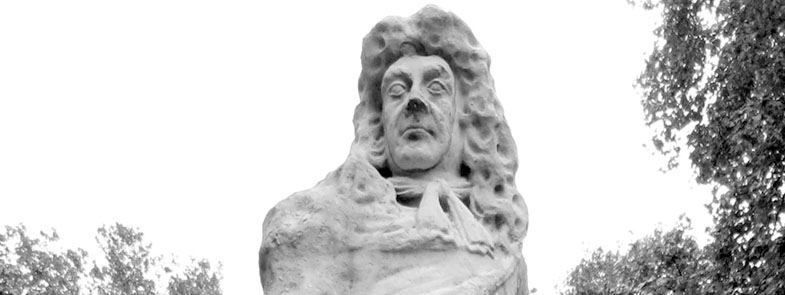Built in the 1670’s, Soho Square was the place to live in London. Originally named King’s Square for King Charles II, it was a highly fashionable place to be and at its centre, was a grand statue of the king.
Designed by Danish sculptor Caius Gabriel Cibber, the King Charles II statue formed part of the centrepiece fountain, erected in 1681. At each corner was a statue of different river gods, to represent the Thames, Severn, Humber and Tyne rivers.
Unfortunately, time wasn’t kind to Soho Square of the statue. By the 19th century, the statue was in a state of disrepair. It had been badly mutilated, its left arm and leg missing, the inscriptions at its base, illegible. Finally, in 1875, the fountain itself was demolished during alterations, but Thomas Blackwell, of Crosse & Blackwell, rescued the Charles II statue.
The condiment firm owner gave it to his artist friend, owner of Grim’s Dyke at that time, Fredrick Goodall. Goodall agreed to take it from Blackwell for safekeeping, as he had the intention to eventually restore it at a later date – and this is where the statue of Charles II stayed.
Dramatist Sir William Schwenck Gilbert bought the Grim’s Dyke property from Goodall in 1890. At this point, the statue of Charles II had been sitting at the centre of the lake at Grim’s Dyke for approximately 15 years, so it obviously came with the property.
 Despite a request from Crosse & Blackwell for the statue to be returned, it stayed in the same position, at the centre of the Grim’s Dyke lake, until Gilbert’s death in 1911. It has been noted that Gilbert had previously ignored Crosse & Blackwell’s request to have the statue returned, so it fell to his widow, Lady Gilbert, to put this right.
Despite a request from Crosse & Blackwell for the statue to be returned, it stayed in the same position, at the centre of the Grim’s Dyke lake, until Gilbert’s death in 1911. It has been noted that Gilbert had previously ignored Crosse & Blackwell’s request to have the statue returned, so it fell to his widow, Lady Gilbert, to put this right.
Lady Gilbert left instructions in her will that, upon her death the statue of Charles II was to finally be returned to the committee responsible for the upkeep of Soho square. The Charles II statue was finally returned home to Soho square, albeit a short distance north of its original place, in 1938.
Photo Credit: Bob Speel and London Traveller


